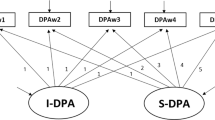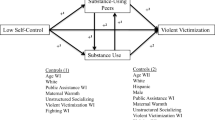Abstract
The study applies individual trait and opportunity perspectives at the individual-level factors associated with peer victimization among South Korean youth. The theoretical analysis integrates individual-level perspectives with community-level perspective. Data are derived from the Korean Youth Panel Survey, which provided information for a sample of 2844 adolescents, aged 11. Findings revealed significant effects of low self-control and risky lifestyles (delinquent peer associations and juvenile delinquency) on peer victimization. The results lend support for the application of self-control theory as well as lifestyles and routine activities theory to understand peer victimization of adolescents in South Korea. However, there was no independent effect of neighborhood collective efficacy on peer victimization, nor did neighborhood collective efficacy attenuate or condition the individual-level effects on peer victimization.

Similar content being viewed by others
References
Bentler, P. M. (2005). EQS 6 structural equations program manual. Encino, CA: Multivariate Software.
Berg, M. T., & Loeber, R. (2011). Examining the neighborhood context of the violent offending-victimization relationship: A prospective investigation. Journal of Quantitative Criminology, 27(4), 427–451.
Berg, M. T., Stewart, E. A., Schreck, C. J., & Simons, R. L. (2012). The victim–offender overlap in context: Examining the role of neighborhood street culture. Criminology, 50(2), 359–390.
Bursik, R., & Grasmick, H. (1993). Neighborhoods and crime: The dimensions of effective community control. Lexington, KY: Lexington Books.
Byrne, B. M. (2012). Structural equation modeling with Mplus: Basic concepts, applications, and programming. New York: Routledge.
Cho, S., Wooldredge, J., & Sun Park, C. (2015). Lifestyles/routine activities and bullying among South Korean youths. Victims and Offenders, 11(2), 285–314.
Choi, I., & Park, S. (1994). Urbanization and crime in Korea: Changing distributions of crime rates among cities. Seoul, South Korea: Korean Institute of Criminology.
Cohen, L. E., & Felson, M. (1979). Social change and crime rate trends: A routine activities approach. American Sociological Review, 44(4), 588–608.
Cohen, L. E., Kluegel, J. R., & Land, K. C. (1981). Social inequality and predatory criminal victimization: An exposition and test of a formal theory. American Sociological Review, 46, 505–524.
Espelage, D. L., Bosworth, K., & Simon, T. R. (2000). Examining the social context of bullying behaviors in early adolescence. Journal of Counseling & Development, 78(3), 326–333.
Fox, K. A., & Bouffard, L. A. (2015). Violent victimization vulnerability: Testing a conceptual model of personality, social, and community fctors. Deviant Behavior, 36(11), 910–934.
Garofalo, J. (1987). Reassessing the lifestyle model of criminal victimization. In M. Gottfredson, & T. Hirschi (Eds.), Positive criminology (pp. 23–42). Newbury Park, CA: Sage.
Gottfredson, M. R., & Hirschi, T. (1990). A general theory of crime. Stanford, CA: Stanford University Press.
Grasmick, H. G., Tittle, C. R., Bursik, R. J., & Arneklev, B. J. (1993). Testing the core empirical implications of Gottfredson and Hirschi’s general theory of crime. Journal of Research in Crime and Delinquency, 30(1), 5–29.
Haynie, D. L., & Osgood, D. W. (2005). Reconsidering peers and delinquency: How do peers matter? Social Forces, 84(2), 1109–1130.
Healey, J. F. (2006). Race, ethnicity, gender, and class: The sociology of group conflict and change. Thousand Oaks, CA: Sage.
Heck, R. H. (2001). Multilevel modeling with SEM. In G. A. Marcoulides & R. E. Schumacker (Eds.), New developments and techniques in structural equation modeling, 89–128. Mahwah, NJ: Erlbaum.
Hindelang, M. J. (1976). Criminal victimization in eight American cities: A descriptive analysis of common theft and assault. Cambridge, MA: Ballinger.
Hindlang, M. J., Gottfredson, M. R., & Garofalo, J. (1978). Victims of personal crime: An empirical foundation for a theory of personal victimization. Cambridge, MA: Ballinger.
Hong, J. S., & Espelage, D. L. (2012). A review of research on bullying and peer victimization in school: An ecological systems analysis. Aggression and Violent Behavior, 17(4), 311–322.
Jennings, W. G., Higgins, G. E., Tewksbury, R., Gover, A. R., & Piquero, A. R. (2010). A longitudinal assessment of the victim–offender overlap. Journal of Interpersonal Violence, 25(12), 2147–2174.
Jensen, G. F., & Brownfield, D. (1986). Gender, lifestyles, and victimization: Beyond routine activity. Violence and Victims, 1(2), 85–99.
Joo, H. (2003). Crime and crime control. Social Indicators Research, 62, 239–263.
Jung, H., & Park, S. (2010). Changes in victimization and its predictors in early adolescence. Korean Criminological Review, 21, 149–173.
Kim, E., Kwak, D. H., & Yun, M. (2010). Investigating the effects of peer association and parental influence on adolescent substance use: A study of adolescents in South Korea. Journal of Criminal Justice, 38, 17–24.
Lauritsen, J. L., & Laub, J. H. (2007). Understanding the link between victimization and offending: New reflections on an old idea. In M. Hough, & M. Maxfield (Eds.), Surveying crime in the 21st century: Commemorating the 25th anniversary of the British Crime Survey (pp. 55–75). Monsey, NY: Criminal Justice Press.
Lee, S. (1995). The relationship between leisure lifestyle and juvenile delinquency. Journal of Korean Sociology of Sport, 4, 161–182.
Lee, M. (2003). Moderating effects of daily life activity experiences on the relationship between stress and violent behaviors in early adolescence. Korean Journal of Psychological and Social Issues, 16, 87–111.
Lee, C. H., & Song, J. (2012). Functions of parental involvement and effects of school climate on bullying behaviors among South Korean middle school students. Journal of Interpersonal Violence, 27(12), 2437–2464.
Maimon, D., & Browning, C. R. (2010). Unstructured socializing, collective efficacy, and violent behavior among urban youth. Criminology, 48(2), 443–474.
Martinez, R., Stowell, J. I., & Lee, M. T. (2010). Immigration and crime in an era of transformation: A longitudinal analysis of homicides in San Diego neighborhoods, 1980–2000. Criminology, 48(3), 797–829.
Meier, R. F., & Miethe, T. D. (1993). Understanding theories of criminal victimization. Crime and Justice, 17, 459–499.
Miethe, T. D., & McDowall, D. (1993). Contextual effects in models of criminal victimizations. Social Forces, 71, 741–759.
Miethe, T. D., & Meier, R. F. (1990). Opportunity, choice, and criminal victimization: A test of a theoretical model. Journal of Research in Crime and Delinquency, 27(3), 243–266.
Miethe, T. D., & Meier, R. F. (1994). Crime and its social context. Albany, NY: SUNY Press.
Miethe, T. D., Stafford, M. C., & Sloane, D. (1990). Lifestyle changes and risks of criminal victimization. Journal of Quantitative Criminology, 6(4), 357–376.
Moon, B., Morash, M., Jeong, S., & Yoon, H. S. (2015). Gender differences in the routine activities associated with risks for larceny in South Korea. International Journal of Offender Therapy and Comparative Criminology, 60(11), 1327–1343. doi: 0306624X15578631.
Muthen, L., & Muthen, B. (2011). Mplus user’s guide. 6th edn Los Angeles, CA: Muthen & Muthen.
Noh, S. (2007). Effects of deviant lifestyles on youth criminal victimization: Analysis of youth panel data. Korean Journal of Victimology, 15, 257–284.
Ousey, G. C., Wilcox, P., & Fisher, B. S. (2011). Something old, something new: Revisiting competing hypotheses of the victimization-offending relationship among adolescents. Journal of Quantitative Criminology, 27(1), 53–84.
Outlaw, M., Ruback, B., & Britt, C. (2002). Repeat and multiple victimizations: The role of individual and contextual factors. Violence and Victims, 17(2), 187–204.
Pauwells, L. J. R., & Svensson, R. (2011). Exploring the relationship between offending and victimization: What is the role of risky lifestyles and low self-control? A test in two urban samples. European Journal on Criminal Policy and Research, 17, 163–177.
Pizarro, J. M., Corsaro, N., & Yu, S. S. V. (2007). Journey to crime and victimization: An application of routine activities theory and environmental criminology to homicide. Victims and Offenders, 2(4), 375–394.
Pratt, T. C., Holtfreter, K., & Reisig, M. D. (2010). Routine online activity and internet fraud targeting: Extending the generality of routine activity theory. Journal of Research in Crime and Delinquency, 47(3), 267–296.
Raudenbush, S. W., Bryk, A. S., & Congdon, R. T. (2006). HLM version 6.03. Chicago, IL: Scientific Software International.
Reisig, M. D., & Pratt, T. C. (2011). Low self-control and imprudent behavior revisited. Deviant Behavior, 32(7), 589–625.
Roh, S., Kim, E., & Yun, M. (2010). Criminal victimization in South Korea: A multilevel approach. Journal of Criminal Justice, 38(3), 301–310.
Sampson, R. J. (1997). Collective regulation of adolescent misbehavior validation results from eighty Chicago neighborhoods. Journal of Adolescent Research, 12(2), 227–244.
Sampson, R. J., & Groves, W. B. (1989). Community structure and crime: Testing social-disorganization theory. American Journal of Sociology, 94, 774–802.
Sampson, R. J., & Lauritsen, J. L. (1990). Deviant lifestyles, proximity to crime, and the offender-victim link in personal violence. Journal of Research in Crime and Delinquency, 27(2), 110–139.
Sampson, R. J., & Raudenbush, S. W. (2004). Seeing disorder: Neighborhood stigma and the social construction of “broken windows”. Social Psychology Quarterly, 67(4), 319–342.
Sampson, R. J., Raudenbush, S. W., & Earls, F. (1997). Neighborhoods and violent crime: A multilevel study of collective efficacy. Science, 277(5328), 918–924.
Schreck, C. J. (1999). Criminal victimization and low self-control: An extension and test of a general theory of crime. Justice Quarterly, 16(3), 633–654.
Schreck, G. J., Miller, J. M., & Gibson, G. L. (2003). Trouble in the school yard: A study of the risk factors of victimization at school. Crime and Delinquency, 49, 460–484.
Schreck, C. J., Stewart, E. A., & Fisher, B. S. (2006). Self-control, victimization, and their influence on delinquency and delinquent friends: A longitudinal analysis using panel data. Journal of Quantitative Criminology, 22(4), 319–340.
Schreck, C. J., Stewart, E. A., & Osgood, D. W. (2008). A reappraisal of the overlap of violent offenders and victims. Criminology, 46(4), 871–906.
Schreck, C. J., Wright, R. A., & Miller, J. M. (2002). A study of individual and situational antecedents of violent victimization. Justice Quarterly, 19(1), 159–180.
Sekol, I., & Farrington, D. P. (2010). The overlap between bullying and victimization in adolescent residential care: Are bully/victims a special category? Children and Youth Services Review, 32(12), 1758–1769.
Shaw, C. R., & McKay, H. D. (1942). Juvenile delinquency and urban areas. Chicago, IL: University of Chicago Press.
Smith, D. J., & Ecob, R. (2007). An investigation into causal links between victimization and offending in adolescents. The British Journal of Sociology, 58(4), 633–659.
Sohn, J. (2001). An analysis of bullying reduction effects of organized after-school physical activities among elementary school students. Korean Journal of Sport Pedagogy, 8, 119–129.
Stewart, E. A., Elifson, K. W., & Sterk, C. E. (2004). Integrating the general theory of crime into an explanation of violent victimization among female offenders. Justice Quarterly, 21(1), 159–181.
Tillyer, M. S., Fisher, B. S., & Wilcox, P. (2011). The effects of school crime prevention on students’ violent victimization, risk perception, and fear of crime: A multilevel opportunity perspective. Justice Quarterly, 28(2), 249–277.
Truman, J. L., & Rand, M. R. (2010). Criminal victimization, 2009. Washington DC: Bureau of Justice Statistics. (U.S. Department of Justice Office of Justice Programs)
Turanovic, J. J., & Pratt, T. C. (2013). The consequences of maladaptive coping: Integrating general strain and self-control theories to specify a causal pathway between victimization and offending. Journal of Quantitative Criminology, 29(3), 321–345.
Turanovic, J. J., & Pratt, T. C. (2014). “Can’t stop, won’t stop”: Self-control, risky lifestyles, and repeat victimization. Journal of Quantitative Criminology, 30(1), 29–56.
Woo, Y. K., & Cho, S. J. (2013). Routine activities, self-control, and direct-contact victimization in Korean adolescents. Korean Journal of Criminology, 7(1), 243–279.
You, S., & Yoon, J. (2016). Peer victimization: Exploring psychosocial correlates and reciprocal longitudinal relationship. Journal of Community Psychology, 44(4), 426–441.
Yun, M., Kim, E., & Park, W. S. (2016). A test of an integrative model using social factors and personality traits prediction on the delinquency of South Korean youth. International Journal of Offender Therapy and Comparative Criminology, (in press) 1–26.
Zaykowski, H., & Gunter, W. (2012). Youth victimization school climate or deviant lifestyles? Journal of Interpersonal Violence, 27(3), 431–452.
Author information
Authors and Affiliations
Corresponding author
Ethics declarations
Conflict of interest
The author declares that she has no conflict of interest.
Additional information
Funding
The current study received no funding.
Rights and permissions
About this article
Cite this article
Cho, S. Self-Control and Risky Lifestyles in Context: Cross-Level Integration between Opportunity and Collective Efficacy in the Study of Peer Victimization among South Korean Youth. J Child Fam Stud 26, 67–79 (2017). https://doi.org/10.1007/s10826-016-0554-y
Published:
Issue Date:
DOI: https://doi.org/10.1007/s10826-016-0554-y




